

TIP: Concepts. Mental models are representations of reality that people use to understand specific phenomena.
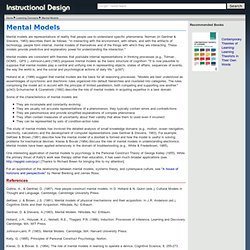
Norman (in Gentner & Stevens, 1983) describes them as follows: "In interacting with the environment, with others, and with the artifacts of technology, people form internal, mental models of themselves and of the things with which they are interacting. These models provide predictive and explanatory power for understanding the interaction. " Mental models are consistent with theories that postulate internal representations in thinking processes (e.g., Tolman , GOMS , GPS ). Johnson-Laird (1983) proposes mental models as the basic structure of cognition: "It is now plausible to suppose that mental models play a central and unifying role in representing objects, states of affairs, sequences of events, the way the world is, and the social and psychological actions of daily life.
" (p397) Mental Model Diagrams (Cartoon) Advertisement We tend to carefully create our HTML and CSS, and meticulously place every pixel to our designs.
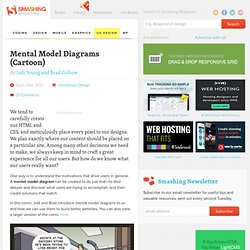
We plan exactly where our content should be placed on a particular site. Among many other decisions we need to make, we always keep in mind to craft a great experience for all our users. But how do we know what our users really want? One way is to understand the motivations that drive users in general. In this comic, Indi and Brad introduce mental model diagrams to us and how we can use them to build better websites. Feel free to share your thoughts on mental model diagrams in the comments section below. (il) It's done. Indi Young and Brad Colbow When not researching mental model diagrams, teaching workshops, or writing, Indi Young consults for non-profits, corporations, start-ups, agencies, and universities around the world. Rosenfeld Media.
Aligning Design Strategy with Human Behavior Published: February 2008 Paperback: 299 pages, ISBN 1-933820-06-3 Digital: ISBN 1-933820-19-5 by Indi Young Indi Young's new book is a welcome addition, covering an aspect of the design process that is extremely important but often neglected.
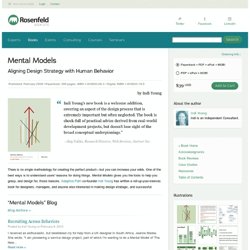
The book is chock-full of practical advice derived from real-world development projects, but doesn't lose sight of the broad conceptual underpinnings. " —Ray Valdes, Research Director, Web Services, Gartner Inc. There is no single methodology for creating the perfect product—but you can increase your odds. Mental Models. Virtual Seminar: Mental Models. When it comes to your users, do you really know what they want?

Is your team struggling to agree on a common design because everyone has a different opinion about what’s right? Are you unsure how to organize your site or product to match user expectations? Design teams work hard to address the entire user experience, yet many don't have the right techniques to uncover all the information occupying a user's attention. To build a robust design, it's essential that design teams firmly understand what users want to get done. That’s where mental models come in. To help you get into the head of your customers, we’ve turned to expert UX designer, Indi Young, who has written the hot off the press book, Mental Models: Aligning Design Strategy with Human Behavior. In this Virtual Seminar, Indi will introduce you to the concept of Mental Models, a method for modeling the attention flow of your users. What Is Your Mental Model? Rosenfeld Media has just released Indi Young’s Mental Models: Aligning Design Strategy With Human Behavior.
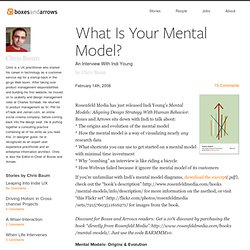
Boxes and Arrows sits down with Indi to talk about: * The origins and evolution of the mental model * How the mental model is a way of visualizing nearly any research data * What shortcuts you can use to get started on a mental model with minimal time investment * Why “combing” an interview is like riding a bicycle * How Webvan failed because it ignore the mental model of its customers If you’re unfamiliar with Indi’s mental model diagrams, download the excerpt(.pdf), check out the “book’s description”: for more information on the method, or visit “this Flickr set”: for images from the book.
Discount for Boxes and Arrows readers: Get a 10% discount by purchasing the book “directly from Rosenfeld Media”: Just use the code BARMMM10. Mental Models. Mental Models and Usability Depaul University, Cognative Psychology 404 November 15, 1999 Mary Jo Davidson, Laura Dove, Julie Weltz Introduction Mental models have been studied by cognitive scientists as part of efforts to understand how humans know, perceive, make decisions, and construct behavior in a variety of environments.
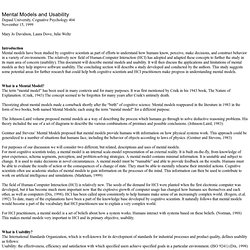
Emotional Interface Design: The Gateway to Passionate Users. Noah Raford on Lift Conference 2013. Which Cognitive Psychology books would you recommend? Gestalt Psychology and webdesign. Get Mental Notes. Pattern recognition (psychology) The incoming sensory information is compared directly to copies (templates) stored in the long term memory.

These copies are stored in the process of our past experiences and learning. E.g. A A A are all recognized as the letter A but not B. Note: This does not allow for variation in letters unless there are templates for each variation. Prototype means a concept of average characteristics of a particular subject. According to this theory, the sensory system breaks down the incoming stimuli into its features and processes the information. DetectionPattern dissectionFeature comparison in memoryRecognition Top down processing can be seen as processing what one is perceiving using past information. Hierarchy of detectors: Feature detectors — lowest and highest; respond to curves, edges, etc.Geon detectors — activated by feature detectorsHigher level detectors — recognize combinations of features and geons The human tendency to see patterns that do not actually exist is called apophenia.
Creating an information architecture. Learnability matters » Blog Archive » Mental Models- An Overview. Let us first understand what a mental model is.
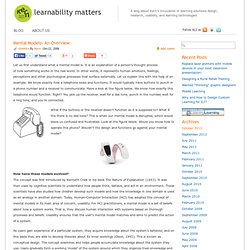
It is an explanation of a person’s thought process of how something works in the real world. In other words, it represents human emotions, feelings, perceptions and other psychological processes that surface externally. Let us explain this with the help of an example. We know exactly how a telephone looks and functions. It would typically have buttons to punch in a phone number and a receiver to communicate. What if the buttons or the receiver doesn’t function as it is supposed to? Mental model. A mental model is an explanation of someone's thought process about how something works in the real world.

It is a representation of the surrounding world, the relationships between its various parts and a person's intuitive perception about his or her own acts and their consequences.